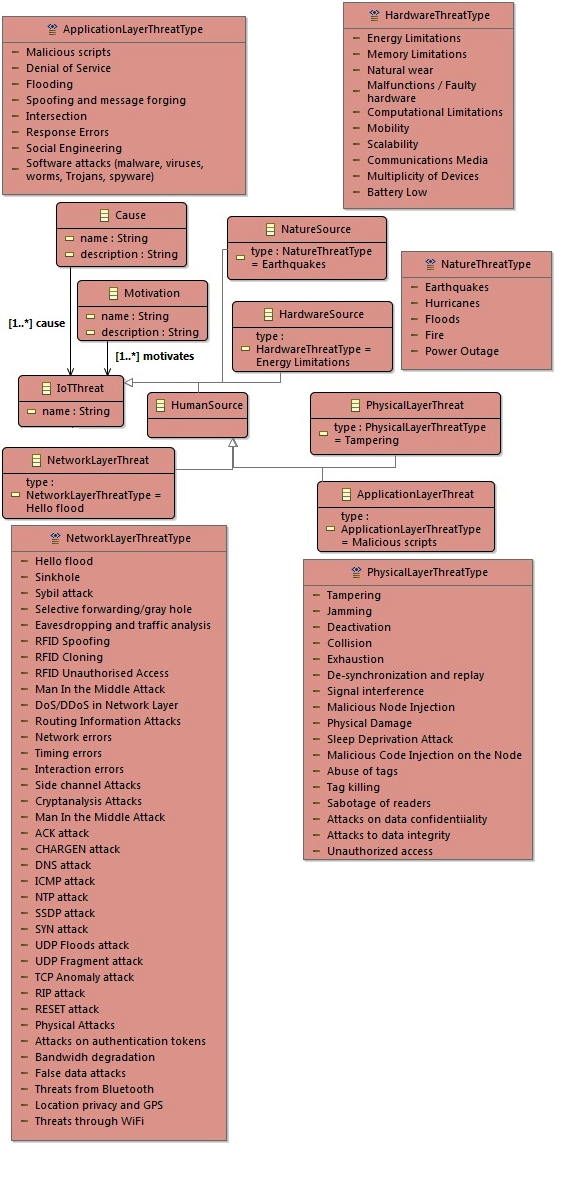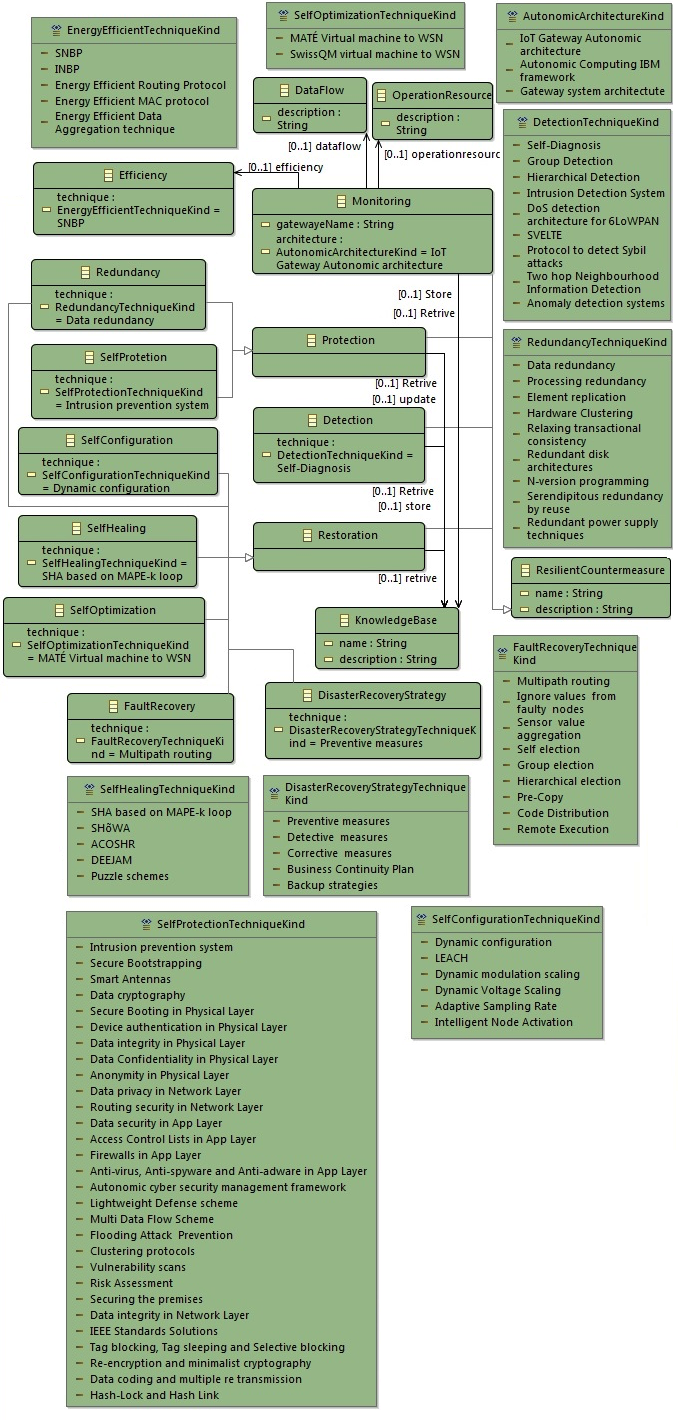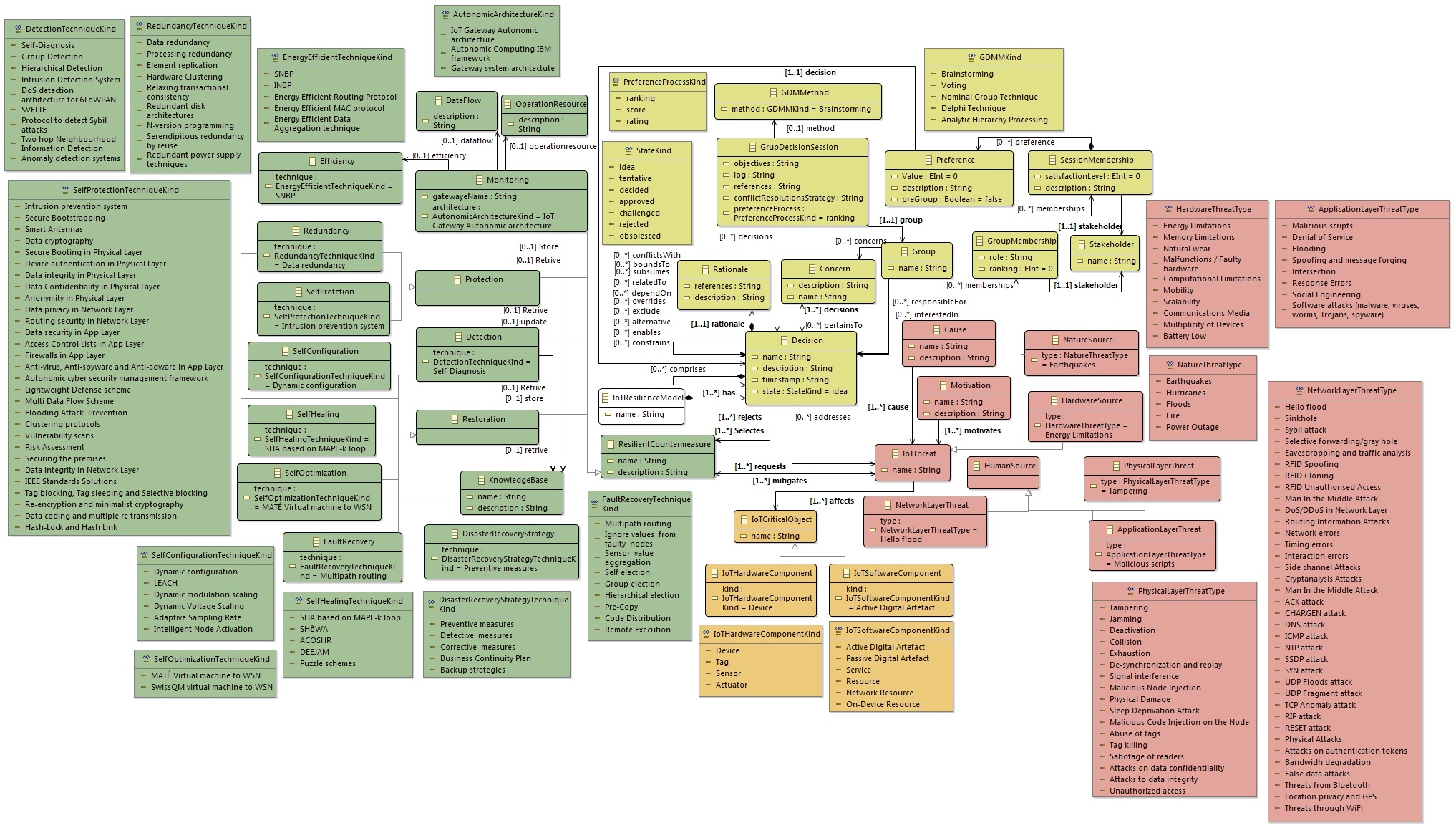References
[1] Adnan Ahmed and Syed Shahram Hussain. 2007. Meta-model of resilient information system.
[2] Aintzane Armentia, Unai Gangoiti, Rafael Priego, Elisabet Estévez, andMarga Marcos. 2015. Flexibility support for homecare applicationsbased on models and multi-agent technology.Sensors15, 12 (2015),31939–31964.
[3] Qazi Mamoon Ashraf and Mohamed Hadi Habaebi. 2015. Autonomicschemes for threat mitigation in Internet of Things. Journal of Networkand Computer Applications49 (2015), 112–127.
[4] QAZI MAMOON Ashraf and MOHAMED HADI Habaebi. 2015. Introducing autonomy in internet of things. Recent Advances in ComputerScience, WSEAS Publishing(2015), 215–221.
[5] Qazi Mamoon Ashraf, Mohamed Hadi Habaebi, Gopinath Rao Sinniah,Musse Mohamud Ahmed, Sheroz Khan, and Shihab Hameed. 2014.Autonomic protocol and architecture for devices in Internet of Things. In2014 IEEE Innovative Smart Grid Technologies-Asia (ISGT ASIA). IEEE,737–742.
[6] Marco Autili, Amleto Di Salle, Francesco Gallo, Alexander Perucci, andMassimo Tivoli. 2015. Biological Immunity and Software Resilience:Two Faces of the Same Coin?. InInternational Workshop on SoftwareEngineering for Resilient Systems. Springer, 1–15.
[7] Alessandro Bassi, Martin Bauer, Martin Fiedler, and Rob van Kranen-burg. 2013.Enabling things to talk. Springer-Verlag GmbH.
[8] Eleonora Borgia. 2014. The Internet of Things vision: Key features,applications and open issues.Computer Communications54 (2014),1–31.
[9] Ashik Chandra. 2010. Synergy between biology and systems resilience.(2010).
[10] Petar Čisar, Sanja Maravić Čisar, and Branko Markoski. 2014. Implementation of immunological algorithms in solving optimization problems. Acta Polytechnica Hungarica11, 4 (2014).
[11] OpenIoT Consortium et al. 2013. OPENIoT project description.
[12] Dipankar Dasgupta and Nii Attoh-Okine. 1997. Immunity based systems: A survey. In1997 IEEE International Conference on Systems, Man,and Cybernetics. Computational Cybernetics and Simulation, Vol. 1.IEEE, 369–374.
[13] Soumya Kanti Datta, Christian Bonnet, and Navid Nikaein. 2014. AnIoT gateway centric architecture to provide novel M2M services. In2014 IEEE World Forum on Internet of Things (WF-IoT). IEEE, 514–519.
[14] Sofie De Rouck, An Jacobs, and Mark Leys. 2008. A methodology forshifting the focus of e-health support design onto user needs: a casein the homecare field.International journal of medical informatics77,9 (2008), 589–601.
[15] Kemal A Delic. 2016. On resilience of iot systems: The internet ofthings (ubiquity symposium).Ubiquity2016, February (2016), 1.
[16] Bruno Dorsemaine, Jean-Philippe Gaulier, jean-philippe Wary, NizarKheir, and Pascal Urien. 2015. Internet of Things: A Definition Taxon-omy. https://doi.org/10.1109/NGMAST.2015.71
[17] Vangelis Gazis, Manuel Goertz, Marco Huber, Alessandro Leonardi,Kostas Mathioudakis, Alexander Wiesmaier, and Florian Zeiger. 2015.Short paper: IoT: Challenges, projects, architectures. In2015 18th Inter-national Conference on Intelligence in Next Generation Networks. IEEE,145–147.
[18] Kashif Habib and Wolfgang Leister. 2015. Threats identification forthe smart internet of things in eHealth and adaptive security counter-measures. In2015 7th International Conference on New Technologies,Mobility and Security (NTMS). IEEE, 1–5.
[19] Ji-De Huang and Han-Chuan Hsieh. 2013. Design of gateway for mon-itoring system in IoT networks. In2013 IEEE International Conferenceon Green Computing and Communications and IEEE Internet of Thingsand IEEE Cyber, Physical and Social Computing. IEEE, 1876–1880.
[20]Cristovao Iglesias, Claudio Miceli, and David Silva. 2019. A DomainModel for Personalized Monitoring System Based on Context-AwareData Fusion. In2019 22nd International Conference on InformationFusion (FUSION). IEEE, 1–5.
[21]Sidra Ijaz, Munam Ali Shah, Abid Khan, and Mansoor Ahmed. 2016.Smart cities: A survey on security concerns.International Journal ofAdvanced Computer Science and Applications7, 2 (2016), 612–625.
[22] Anton Jansen and Jan Bosch. 2005. Software architecture as a set ofarchitectural design decisions. In5th Working IEEE/IFIP Conference onSoftware Architecture (WICSA’05). IEEE, 109–120.
[23] Chris A Kaiser, Monty Krieger, Harvey Lodish, and Arnold Berk. 2007.Molecular cell biology.WH Freeman.
[24] Bhaskar Krishnamachari and Sitharama Iyengar. 2004. DistributedBayesian algorithms for fault-tolerant event region detection in wire-less sensor networks.IEEE Trans. Comput.3 (2004), 241–250.
[25] Fang-Yie Leu and Zhi-Yang Li. 2009. Detecting DoS and DDoS attacksby using an intrusion detection and remote prevention system. In2009Fifth International Conference on Information Assurance and Security,Vol. 2. IEEE, 251–254.
[26] Huichen Lin and Neil Bergmann. 2016. IoT privacy and securitychallenges for smart home environments.Information7, 3 (2016), 44.
[27] Dong Liu, Ralph Deters, and Wen-Jun Zhang. 2010. Architecturaldesign for resilience.Enterprise Information Systems4, 2 (2010), 137–152.
[28] Ivano Malavolta, Henry Muccini, and Smrithi Rekha. 2014. Enhancingarchitecture design decisions evolution with group decision makingprinciples. InInternational Workshop on Software Engineering for Re-silient Systems. Springer, 9–23.
[29] Friedemann Mattern and Christian Floerkemeier. 2010. From theInternet of Computers to the Internet of Things. InFrom active datamanagement to event-based systems and more. Springer, 242–259.
[30] Enzo Mingozzi. 2013. BETaaS: Building the Environment for the Thingsas a Service. In4th ETSI M2M Workshop.
[31] Pramod Nagalgaonkar, Dhanraj Biradar, and Gaikwad Ranjit Shar-nappa. 2015. Review on Fault Detection and Recovery in WSN.Inter-national Journal of Advanced Research inComputer Science and SoftwareEngineering5 (08 2015).
[32] Peter Parham. 2014.The immune system. Garland Science.
[33] Hunor Sándor, Béla Genge, and Gheorghe Sebestyén-Pál. 2015. Re-silience in the Internet of Things: The software defined networkingapproach. In 2015 IEEE International Conference on Intelligent ComputerCommunication and Processing (ICCP). IEEE, 545–552.
[34] Mojtaba Shahin, Peng Liang, and Mohammad Reza Khayyambashi.2009. Architectural design decision: Existing models and tools. In2009 Joint Working IEEE/IFIP Conference on Software Architecture &European Conference on Software Architecture. IEEE, 293–296.
[35] Jeff Tyree. 2005. Architectural design decisions session report. In5th Working IEEE/IFIP Conference on Software Architecture (WICSA’05).IEEE, 285–286.
[36] Emmanouil Vasilomanolakis, Jörg Daubert, Manisha Luthra, VangelisGazis, Alex Wiesmaier, and Panayotis Kikiras. 2015. On the securityand privacy of Internet of Things architectures and systems. In2015International Workshop on Secure Internet of Things (SIoT). IEEE, 49–57.
[37] Ovidiu Vermesan, Peter Friess, et al.2014.Internet of things-fromresearch and innovation to market deployment. Vol. 29. River publishersAalborg.
[38] ADDM4RIOTA Website. 2019. Retrieved March 7, 2019 from http://addm4riota.labnet.nce.ufrj.br
[39] Suitability of software architecture decision making methods for group decisions
[40] A study on group decision-making in software architecture
[41] Quantifying the value of architecture design decisions: lessons from the field
[42] Pooling of Unshared Information in Group Decision Making: Bi-ased Information Sampling During Discussion





